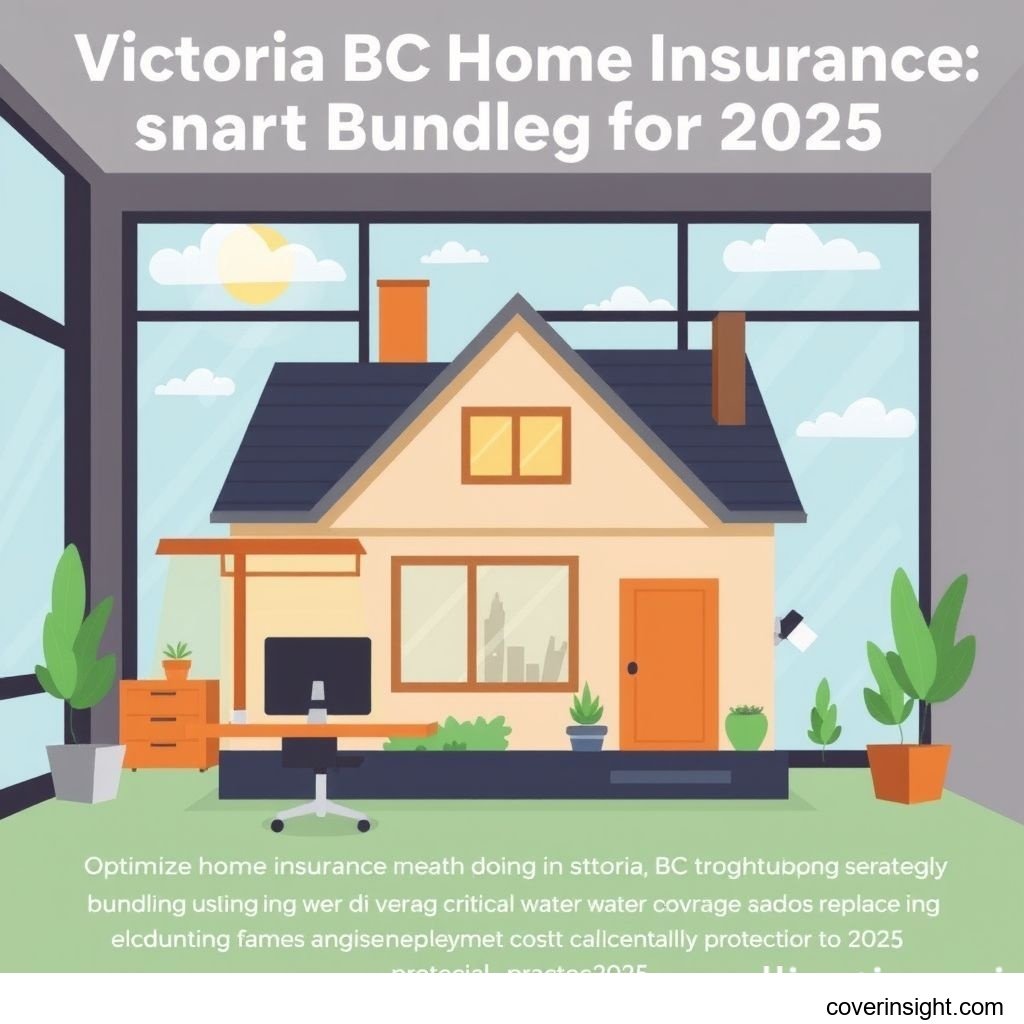Introduction
As 2025 unfolds, securing comprehensive home insurance in Victoria, BC, remains a top priority for homeowners. With the rising cost of living, finding smart ways to manage household expenses is more critical than ever. One of the most effective strategies for significant savings on your premiums is leveraging bundling discounts Canada. This approach, where you combine multiple insurance policies—typically home and auto—with the same provider, can lead to substantial reductions in your overall insurance costs. It’s not just about convenience; it's about putting more money back in your pocket while ensuring your most valuable assets are well-protected.
Coverage Details
Understanding what your home insurance policy covers, and what it doesn't, is fundamental to making an informed decision. For more general insights into securing your assets, consider exploring Insurance Resources Global.
What’s Included
A standard home insurance policy in Victoria typically includes several key areas of protection:
-
Dwelling Coverage: This protects the physical structure of your home, including attached garages, decks, and sheds, against perils like fire, windstorms, hail, and vandalism. Given the robust housing market, ensuring your dwelling coverage reflects the current replacement cost, not just the market value, is crucial.
-
Personal Property Coverage: This covers the contents of your home, such as furniture, electronics, clothing, and other personal belongings, whether they are inside your home or temporarily removed (e.g., at a storage locker).
-
Personal Liability Coverage: This provides financial protection if someone is injured on your property and you are found legally responsible, or if you accidentally cause damage to someone else's property.
-
Additional Living Expenses (ALE): Should your home become uninhabitable due due to a covered loss, ALE coverage helps pay for temporary accommodation, food, and other increased living costs while repairs are underway.
Common Exclusions
While comprehensive, home insurance policies do have common exclusions that are important to be aware of:
-
Earthquake Damage: Given Victoria's location in a seismically active zone, earthquake coverage is almost always an add-on, not included in standard policies. It's a critical consideration for many BC homeowners.
-
Flood Damage: Damage from overland flooding (e.g., rivers overflowing) or sewer backup often requires separate endorsements or policies.
-
Wear and Tear: Gradual deterioration or damage caused by lack of maintenance is not covered. Insurance is for sudden, accidental perils.
-
Pest Infestations: Damage from rodents, insects, or other pests is typically excluded.
-
Acts of War or Terrorism: These catastrophic events are generally not covered by standard policies.
Cost Analysis
Navigating the cost of home insurance can feel like a labyrinth, but understanding the factors at play and knowing how to save can make all the difference. For specific insights into local policy options, you might check out CA Insurance Home.
Price Factors
Several elements weigh heavily on the premium you pay for home insurance in Victoria:
-
Location: Proximity to fire hydrants, fire stations, and the overall crime rate of your neighbourhood can impact your premium.
-
Age and Construction of Your Home: Newer homes with modern building materials and updated electrical/plumbing systems often qualify for lower rates. Older homes might require more extensive coverage for potential issues.
-
Claims History: A history of previous claims, whether by you or previous owners, can increase your rates. Insurers see frequent claims as a higher risk.
-
Deductible Amount: This is the amount you pay out-of-pocket before your insurance kicks in. A higher deductible typically means a lower premium.
-
Credit Score: In some provinces (though less of a direct factor in BC compared to others), insurers may use a credit-based insurance score as part of their underwriting process.
-
Home Security Features: Installed alarm systems, deadbolts, and even neighbourhood watch programs can sometimes lead to discounts.
Saving Tips
Beyond the obvious benefit of bundling discounts Canada, here are some savvy ways to trim your home insurance costs:
-
Increase Your Deductible: As mentioned, opting for a higher deductible can significantly lower your monthly or annual premium. Just ensure you can comfortably afford the deductible if a claim arises.
-
Improve Home Security: Investing in certified alarm systems, smoke detectors, and carbon monoxide detectors can earn you discounts. Some insurers even offer perks for smart home technology.
-
Maintain Your Home: Proactively addressing maintenance issues, like roof repairs or plumbing updates, reduces the likelihood of future claims, which can positively impact your rates over time.
-
Shop Around: Don't settle for the first quote. Get multiple quotes from different providers. A robust market means competitive pricing.
-
Ask About Discounts: Always inquire about other available discounts—for being a loyal customer, a non-smoker, having a new roof, or being mortgage-free.
-
Bundle Your Policies: This is arguably the biggest saver. If you have auto insurance, bundling it with your home insurance can net you a discount of 10-20% or even more on your total premiums. For instance, consider the hypothetical Smith family in Saanich. By bundling their home insurance with their two car insurance policies, they reportedly saved close to 15% on their total premiums annually, a significant chunk that goes right back into their pockets.
FAQs
How much does bundling discounts Canada save?
The savings from bundling policies can vary significantly, but it's not uncommon to see discounts ranging from 5% to 20% on the total premium when combining home and auto insurance. Some insurers might offer even more. It’s always best to get a tailored quote from a few providers to see the exact figures. According to data released by the Insurance Bureau of Canada, bundling is consistently one of the top ways for consumers to reduce their insurance expenditures.
What affects premiums?
Premiums are influenced by a myriad of factors, including the location, age, and construction of your home, your claims history, the chosen deductible, the level of coverage, and installed safety features. Even local government data, such as property assessment values from BC Assessment, can indirectly affect premiums as they reflect the potential replacement cost of your home.
Is home insurance mandatory in Victoria, BC?
While home insurance is not legally mandatory in British Columbia in the same way auto insurance is, it is almost always required by mortgage lenders. If you have a mortgage, your lender will insist on proof of insurance to protect their investment. Without a mortgage, it’s not legally required, but going without coverage is like playing Russian roulette with your largest asset.
How to choose the right home insurance policy?
Choosing the right policy involves balancing cost with comprehensive coverage. Start by assessing your specific needs: what's your home's replacement value? What personal belongings do you need to protect? Consider the risks specific to Victoria, like seismic activity. Compare quotes from several reputable insurers, read policy documents carefully, and don't hesitate to ask questions. The Financial Consumer Agency of Canada offers excellent resources for navigating insurance choices.
What are the consequences of no home insurance coverage?
The consequences of not having home insurance can be devastating. Without it, you would be solely responsible for covering the costs of any damage to your home, personal belongings, or liability claims. This could lead to severe financial hardship or even bankruptcy in the event of a major loss like a fire or significant weather event. Essentially, you'd be on your own if disaster struck.
Author Insight & Experience
As someone living in CA, I've seen firsthand how quickly unexpected events can turn lives upside down. From my professional observations in the insurance sector, I've noticed a common pitfall: people often focus solely on the premium without fully understanding their coverage. It's easy to fall into the trap of "cheapest is best," but when a pipe bursts in the dead of winter or a storm tears through your roof, that penny-pinching can lead to colossal out-of-pocket expenses. My advice? Don't just buy a policy; invest in peace of mind. Ask the tough questions, understand your deductibles, and make sure your coverage truly reflects the value of your home and its contents. A few extra dollars spent on a robust policy today could save you tens of thousands tomorrow.









Comments